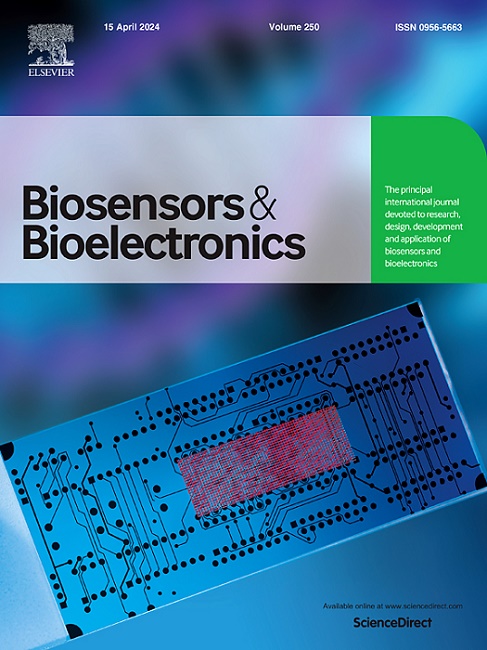One-step copper deposition-induced signal amplification for multiplex bacterial infection diagnosis on a lateral flow immunoassay device
IF 10.7
1区 生物学
Q1 BIOPHYSICS
引用次数: 0
Abstract
The lateral flow immunoassay (LFIA) is predominant in rapid diagnostic tests owing to its cost-effectiveness and operational simplicity. However, the conventional LFIA exhibits limited sensitivity and is susceptible to human variance for the result readout, impacting result interpretation. In this study, we introduced a novel one-step copper deposition-induced signal amplification lateral flow immunoassay (osa-LFIA) that markedly enhances the detection sensitivity for Staphylococcus aureus (protein A) and Pseudomonas aeruginosa (exotoxin A). Utilizing gold nanoparticles (AuNPs) as a catalyst, this approach employs ascorbic acid to reduce Cu2+ to Cu0, depositing on AuNPs at the test line and amplifying the signal. A user-friendly design features a three-dimensional paper structure incorporating pre-dried reagents, enabling a streamlined, efficient testing process. The osa-LFIA significantly lowers detection limits to 3 ng mL−1 for protein A and 10 ng mL−1 for exotoxin A, offering a tenfold improvement over conventional LFIA. Additionally, we developed a portable grayscale detection device, achieving less than 10% error in quantitative analysis compared to the data acquired and analyzed in the lab. This entire process, from detection to signal amplification, is completed in just 20 min. For the clinical trial, we utilized the osa-LFIA to test synovial fluid samples infected with Staphylococcus aureus. We also successfully detected different concentrations of the exotoxin A in parallel, with a recovery value of 96%–110%. Our findings demonstrate the osa-LFIA's potential as a rapid, highly sensitive, and simple-to-use diagnostic tool for detecting various pathogens, significantly advancing the field of rapid diagnostic testing.
一步式铜沉积诱导信号放大技术,用于在侧流免疫测定装置上进行多重细菌感染诊断
侧流免疫分析法(LFIA)因其成本效益高、操作简单而在快速诊断检测中占据主导地位。然而,传统的横向流动免疫测定灵敏度有限,结果读数易受人为因素影响,从而影响结果解读。在这项研究中,我们引入了一种新型的一步铜沉积诱导信号放大侧向流动免疫分析法(osa-LFIA),它能显著提高金黄色葡萄球菌(蛋白 A)和铜绿假单胞菌(外毒素 A)的检测灵敏度。这种方法以金纳米粒子(AuNPs)为催化剂,利用抗坏血酸将 Cu2+ 还原成 Cu0,沉积在检测线上的 AuNPs 上,放大信号。该方法的设计方便用户使用,采用三维纸质结构,内含预干燥试剂,从而简化了测试过程,提高了效率。osa-LFIA大大降低了蛋白A和外毒素A的检测限,分别为3 ng mL-1 和10 ng mL-1,比传统的LFIA提高了10倍。此外,我们还开发了一种便携式灰度检测设备,与在实验室获取和分析的数据相比,定量分析误差小于 10%。从检测到信号放大,整个过程仅需 20 分钟。在临床试验中,我们利用osa-LFIA 检测了感染金黄色葡萄球菌的滑膜液样本。我们还成功地同时检测了不同浓度的 A 型外毒素,回收率在 96%-110% 之间。我们的研究结果表明,osa-LFIA 是一种快速、高灵敏度和简单易用的诊断工具,可用于检测各种病原体,极大地推动了快速诊断检测领域的发展。
本文章由计算机程序翻译,如有差异,请以英文原文为准。
求助全文
约1分钟内获得全文
求助全文
来源期刊

Biosensors and Bioelectronics
工程技术-电化学
CiteScore
20.80
自引率
7.10%
发文量
1006
审稿时长
29 days
期刊介绍:
Biosensors & Bioelectronics, along with its open access companion journal Biosensors & Bioelectronics: X, is the leading international publication in the field of biosensors and bioelectronics. It covers research, design, development, and application of biosensors, which are analytical devices incorporating biological materials with physicochemical transducers. These devices, including sensors, DNA chips, electronic noses, and lab-on-a-chip, produce digital signals proportional to specific analytes. Examples include immunosensors and enzyme-based biosensors, applied in various fields such as medicine, environmental monitoring, and food industry. The journal also focuses on molecular and supramolecular structures for enhancing device performance.
 求助内容:
求助内容: 应助结果提醒方式:
应助结果提醒方式:


